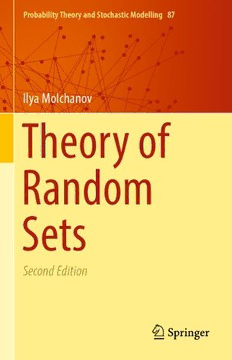Table Of ContentProbability Theory and Stochastic Modelling 87
Ilya Molchanov
Theory of
Random
Sets
Second Edition
Probability Theory and Stochastic Modelling
Volume 87
Editors-in-chief
PeterW.Glynn,Stanford,CA,USA
AndreasE.Kyprianou,Bath,UK
YvesLeJan,Orsay,France
AdvisoryBoard
SørenAsmussen,Aarhus,Denmark
MartinHairer,Coventry,UK
PeterJagers,Gothenburg,Sweden
IoannisKaratzas,NewYork,NY,USA
FrankP.Kelly,Cambridge,UK
BerntØksendal,Oslo,Norway
GeorgePapanicolaou,Stanford,CA,USA
EtiennePardoux,Marseille,France
EdwinPerkins,Vancouver,Canada
HalilMeteSoner,Zürich,Switzerland
TheProbabilityTheoryandStochasticModellingseriesisamergerandcontin-
uationofSpringer’stwowellestablishedseriesStochasticModellingandApplied
ProbabilityandProbabilityandItsApplicationsseries.Itpublishesresearchmono-
graphsthatmakeasignificantcontributiontoprobabilitytheoryoranapplications
domain in which advanced probability methods are fundamental. Books in this
seriesareexpectedtofollowrigorousmathematicalstandards,whilealsodisplaying
the expository quality necessary to make them useful and accessible to advanced
studentsaswellasresearchers.Theseriescoversallaspectsofmodernprobability
theoryincluding
(cid:129) Gaussianprocesses
(cid:129) Markovprocesses
(cid:129) Randomfields,pointprocessesandrandomsets
(cid:129) Randommatrices
(cid:129) Statisticalmechanicsandrandommedia
(cid:129) Stochasticanalysis
aswellasapplicationsthatinclude(butarenotrestrictedto):
(cid:129) Branchingprocessesandothermodelsofpopulationgrowth
(cid:129) Communicationsandprocessingnetworks
(cid:129) Computationalmethodsinprobabilityandstochasticprocesses,includingsimu-
lation
(cid:129) Geneticsandotherstochasticmodelsinbiologyandthelifesciences
(cid:129) Informationtheory,signalprocessing,andimagesynthesis
(cid:129) Mathematicaleconomicsandfinance
(cid:129) Statisticalmethods(e.g.empiricalprocesses,MCMC)
(cid:129) Statisticsforstochasticprocesses
(cid:129) Stochasticcontrol
(cid:129) Stochasticmodelsinoperationsresearchandstochasticoptimization
(cid:129) Stochasticmodelsinthephysicalsciences
Moreinformationaboutthisseriesathttp://www.springer.com/series/13205
Ilya Molchanov
Theory of Random Sets
Second Edition
123
IlyaMolchanov
InstituteofMathematicalStatistics
andActuarialScience
UniversityofBern
Bern,Switzerland
ISSN2199-3130 ISSN2199-3149 (electronic)
ProbabilityTheoryandStochasticModelling
ISBN978-1-4471-7347-2 ISBN978-1-4471-7349-6 (eBook)
DOI10.1007/978-1-4471-7349-6
LibraryofCongressControlNumber:2017949364
MathematicsSubjectClassification(2010):Primary:60D05;Secondary:26E25,28B20,52A22,49J53,
54C65,60B05,60E07,60F15,60G55,60G57,62M30
Originallypublishedintheseries:ProbabilityandItsApplications
©Springer-VerlagLondonLtd.2005,2017
Thisworkissubjecttocopyright.AllrightsarereservedbythePublisher,whetherthewholeorpartof
thematerialisconcerned,specificallytherightsoftranslation,reprinting,reuseofillustrations,recitation,
broadcasting,reproductiononmicrofilmsorinanyotherphysicalway,andtransmissionorinformation
storageandretrieval,electronicadaptation,computersoftware,orbysimilarordissimilarmethodology
nowknownorhereafterdeveloped.
Theuseofgeneraldescriptivenames,registerednames,trademarks,servicemarks,etc.inthispublication
doesnotimply,evenintheabsenceofaspecificstatement,thatsuchnamesareexemptfromtherelevant
protectivelawsandregulationsandthereforefreeforgeneraluse.
Thepublisher,theauthorsandtheeditorsaresafetoassumethattheadviceandinformationinthisbook
arebelievedtobetrueandaccurateatthedateofpublication.Neitherthepublishernortheauthorsor
theeditorsgiveawarranty,expressorimplied,withrespecttothematerialcontainedhereinorforany
errorsoromissionsthatmayhavebeenmade.Thepublisherremainsneutralwithregardtojurisdictional
claimsinpublishedmapsandinstitutionalaffiliations.
Printedonacid-freepaper
ThisSpringerimprintispublishedbySpringerNature
TheregisteredcompanyisSpringer-VerlagLondonLtd.
Theregisteredcompanyaddressis:236Gray’sInnRoad,LondonWC1X8HB,UnitedKingdom
To mymother
Preface
SomeHistory
The study of random geometrical objects goes back to the famous Buffon needle
problem.Similar to the ideas of Geometric Probability,which can be traced back
to the very origins of probability, the conceptof a random set was mentioned for
the first time together with the mathematical foundations of Probability Theory.
A.N.Kolmogorov[493,p.46]wrotein1933(translatedfromGerman):
LetGbeameasurableregionoftheplanewhoseshapedependsonchance;inotherwords,
letusassigntoeveryelementaryevent(cid:2)ofafieldofprobabilityadefinitemeasurableplane
regionG.WeshalldenotebyJtheareaoftheregionGandbyP.x;y/theprobabilitythat
thepoint.x;y/belongstotheregionG.Then
“
E.J/D P.x;y/dxdy:
OnemightobservethatthisisaformulationofRobbins’theoremandP.x;y/isthe
coveragefunctionoftherandomsetG.
Further progress in the theory of random sets relied on developments in the
followingareas:
(cid:129) studies of random elements in general topologicalspaces, in groups and semi-
groups,see,e.g.,Grenander[326];
(cid:129) thegeneraltheoryofstochasticprocesses,seeDellacherie[220],andthetheory
ofcapacities,seeChoquet[172];
(cid:129) set-valuedanalysisandmultifunctions,seeCastaingandValadier[158];
(cid:129) advances in image analysis and microscopy that required a satisfactory
mathematical theory of distributions for binary images (or random sets), see
Serra[790].
The mathematicaltheoryof randomsets can be traced backto Matheron[581]
andKendall[454].Theprincipalnewfeatureisthatrandomsetsmayhavedifferent
shapes and the development of this idea is crucial in the study of random sets.
vii
viii Preface
G. Matheronformulatedthe verydefinitionof a randomclosed set and developed
the relevantprobabilisticand geometric techniques.D.G. Kendall’s seminalpaper
[454]onrandomsetsalreadycontainedthefirststepsintomanyfurtherdirections
suchaslattices,weakconvergence,spectralrepresentation,infinitedivisibility.Most
oftheseaspectswereelaboratedlater oninconnectionwith relevantideasinpure
mathematicsandclassicalprobabilitytheory.Thishasmademanyoftheconcepts
and the notation used in [454] obsolete, so we will follow instead the modern
terminologythatfitsbetterintothesystemdevelopedbyG.Matheron;mostofhis
notationwastakenasthebasisforthismonograph.
The relationship between random sets and convex geometry later on has been
thoroughly explored within the stochastic geometry literature, mostly in the sta-
tionary setting, see, e.g., Schneider and Weil [780]. Within stochastic geometry,
random sets represent one type of object along with point processes and random
tessellations, see Chiu, Stoyan, Kendall and Mecke [169]. The mathematical
morphologypartofG.Matheron’sbookgaverisetonumerousapplicationsinimage
processing (Dougherty [239] and Serra [790]) and abstract studies of operations
withsets,oftenintheframeworkoflatticetheory(Heijmans[355]).
Since1975,whenG.Matheron’sbook[581]waspublished,thetheoryofrandom
setshasenjoyedsubstantialdevelopmentsconcerning
(cid:129) relationshipstothetheoriesofsemigroupsandcontinuouslattices;
(cid:129) propertiesofcapacities;
(cid:129) limittheoremsforMinkowskisumsbasedupontechniquesfromprobabilitiesin
Banachspaces;
(cid:129) limit theorems for unions of random sets in relation to the theory of extreme
values;
(cid:129) stochasticoptimisationideasinrelationtorandomsetsthatappearasepigraphs
ofrandomfunctions;
(cid:129) propertiesoflevelsetsandexcursionsofstochasticprocesses.
These developments constitute the core of this book, which aims to cast the
theory of random sets into the conventionalprobabilistic framework that involves
distributionalproperties,limittheoremsandrelatedanalyticaltools.
Central TopicsoftheBook
This book concentrates on several basic concepts in the theory of random sets.
The first is the capacity functional that determines the distribution of a random
closed set in a locally compact Hausdorff separable space. Unlike probability
measures, the capacity functional is non-additive. The studies of non-additive set
functionsareabundant,especially,inviewofgametheoryapplicationstodescribe
the gainattained bya coalitionof players,in statistics as belief functionsin order
to modelsituations where the underlyingprobability measure is uncertain, and in
mathematicalfinance,wherenon-additivesetfunctionsareessentialtoassessrisk.
Preface ix
The capacity functional can be used to characterise the weak convergence of
randomsets and some propertiesof their distributions.In particular,this concerns
unionsof randomclosedsets, wherethe regularvariationpropertyofthe capacity
functionalisofprimaryimportance.However,thecapacityfunctionaldoesnothelp
to deal with a number of other issues, for instance to define the expectation of a
randomclosedset.
Here the leading role is taken over by the concept of a selection, which is a
(single-valued)randomelementthatalmostsurelybelongstoarandomset.Inthis
framework,itisconvenienttoviewarandomclosedsetasamultifunction(orset-
valued function) on a probability space and use the well-developed machinery of
set-valuedanalysis,see,e.g.,HuandPapageorgiou[402].Bytakingexpectationsof
integrableselections,onedefinestheselectionexpectationofarandomclosedset.
Theselectionexpectationofarandomsetdefinedonanon-atomicprobabilityspace
isalwaysconvexandcanbealternativelydefinedastheconvexsetwhosesupport
functionequalstheexpectedsupportfunctionofarandomset.TheMinkowskisum
of random sets is introduced as the set of sums of all their points (or all their
selections)andcanbeequivalentlydefinedusingthearithmeticsumofthesupport
functions. Therefore, limit theorems for Minkowski sums of random sets can be
derivedfrom the existing results for randomelements in functionalspaces. These
toolsmakeitpossibletoexploreset-valuedmartingales.
Importantexamplesofrandomclosedsetsappearasepigraphsofrandomlower
semicontinuous functions. Viewing the epigraphs as random closed sets makes it
possible to obtain results for lower semicontinuous functions under the weakest
possibleconditions.Inparticular,thisconcernstheconvergenceofminimumvalues
andminimisers,whichisasubjectofstochasticoptimisationtheory.
It is possible to consider the family of closed sets as both a semigroup and a
lattice.Therefore,theresultsonlattice-orsemigroup-valuedrandomelementsare
veryusefulinthetheoryofrandomsets.
Plan
Since the concept of a set is central for mathematics, the book is highly inter-
disciplinary and relies on tools from a number of mathematical theories and
concepts: capacities, convex geometry, set-valued analysis, topology, harmonic
analysisonsemigroups,continuouslattices,non-additivemeasuresandupper/lower
probabilities, limit theorems in Banach spaces, the general theory of stochastic
processes, extreme values, stochastic optimisation, point processes and random
measures.
The bookstarts with the definitionofa randomclosed set. The spaceE which
randomsetsbelongtoisveryoftenassumedtobelocallycompactHausdorffwith
a countable base. The Euclidean space Rd is a generic example. Often we switch
to the more general case of E being a Polish space or Banach space (if a linear
structureisessential).Itisconvenienttoworkwithrandomclosedsets,whichisthe
x Preface
typicalsettinginthisbook,althoughinsomeplaceswementionrandomopensets
andrandomBorelsets.Choquet’stheoremconcerningtheexistenceofrandomset
distributionsisprovedandrelationshipswithset-valuedanalysis(ormultifunctions)
andlatticesareexplained.TherestofChap.1reliesontheconceptofthecapacity
functional.Ithighlightsrelationshipsbetweencapacityfunctionalsandpropertiesof
randomsets,developssomeanalytictheory,convergenceconcepts,applicationsto
pointprocessesandrandomcapacitiesandfinallysurveysvariousinterpretationsfor
capacitiesthatstemfromgametheory,impreciseprobabilitiesandrobuststatistics.
Specialattentionisdevotedtothecaseofrandomconvexcompactsets(orconvex
bodiesifthecarrierspaceisEuclidean).
Chapter2concernsexpectationconceptsforrandomclosedsets.Themainpartis
devotedtotheselection(orAumann)expectationbasedontheideaofanintegrable
selection.Chapter3continuesthistopicbydealingwithMinkowskisumsofrandom
sets.Thedualrepresentationoftheselectionexpectation—asthesetofexpectations
ofallselectionsandastheexpectationofthesupportfunction—makesitpossibleto
refertolimittheoremsinBanachspacesinordertoderivethecorrespondingresults
forrandomclosedsets.
The study of unions for random sets is closely related to extremes of random
variablesandfurthergeneralisationsforpointwiseextremesofstochasticprocesses.
Chapter4describesthemainresultsfortheunionsofrandomsetsandexplainsthe
backgroundideasthat are related to the studiesof lattice-valuedrandomelements
andregularvariationonabstractspaces.
Chapter 5 is devoted to links between random sets and stochastic processes.
This concerns set-valued processes that develop in time, in particular, set-valued
martingales.Furthermore,thisrelatestorandomsetsinterpretationsofconventional
stochastic processes, where random sets appear as graphs, level sets or epigraphs
(hypographs).Severalareasrelatedtorandomsetsandstochasticprocessesareonly
mentionedinbrief,forinstance,thetheoryofset-indexedprocesses,whererandom
sets appear as stopping times (or stopping sets), excursions of random fields, and
potentialtheoryforMarkovprocessesthatprovidesfurtherexamplesofcapacities
relatedtohittingtimesandpathsofstochasticprocesses.
The Appendices summarise the necessary mathematical background; it stems
fromvariouspartsofmathematicsandisnormallyscatteredbetweenvarioustexts.
SecondEdition
Theperiodbetweenthefirstandsecondeditionswitnessedtheappearanceofseveral
booksonstochasticgeometryandrandomsetsauthoredbyNguyen[651],Schneider
and Weil [780], Chiu, Stoyan, Kendalland Mecke [169], on randommeasures by
Kallenberg[444],PoissonpointprocessesbyLastandPenrose[526],andonnon-
additivemeasuresbyGrabisch[321]andCuzzolin[196].

